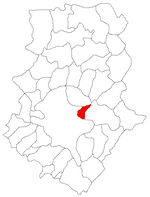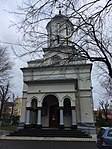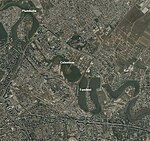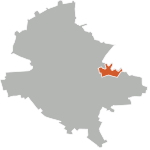Voluntari

Voluntari (Romanian pronunciation: [volunˈtarʲ]) is a town in Ilfov County, Muntenia, Romania. It is located at a distance of 1 km from the northern border of Bucharest (on the DN2 road towards Urziceni) and is thus frequently viewed as a suburb of Bucharest. The population is 47,366 inhabitants according to the 1 December 2021 census, with an ethnic composition, among those for whom data are available, of 94.8% Romanians, 1.3% Romani, 0.9% Chinese, 0.5% Turks, and 2.5% of other ethnic groups. The low price of land, the proximity to Bucharest, and the easy and reliable access to both the railway network and the road network have allowed a steady development of industrial and commercial facilities, especially in the light industry and import/export commerce. The town's output estimate increased by over 25% between 2001 and 2005. Even with such high development rates, many residents commute to Bucharest. Voluntari is the site of a shopping centre known as Jolie Ville Galleria, as well as the headquarters of the Vodafone Romania company. Voluntari literally means "Volunteers", in Romanian, having been founded by the volunteer soldiers who fought for Romania in World War I and were given plots to build their homes there after the war. The settlement received city status in 2004.
Excerpt from the Wikipedia article Voluntari (License: CC BY-SA 3.0, Authors, Images).Voluntari
Bulevardul Voluntari,
Geographical coordinates (GPS) Address Nearby Places Show on map
Geographical coordinates (GPS)
| Latitude | Longitude |
|---|---|
| N 44.4925 ° | E 26.191388888889 ° |
Address
District Volunatri - Centura Nord
Bulevardul Voluntari 99
077010
Romania
Open on Google Maps









